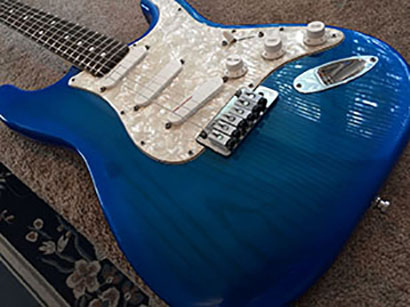
Fender is one of the most iconic names in the music industry, known for revolutionizing electric guitar design and shaping the sound of modern music. From the pioneering days of Leo Fender to its current global influence, Fender has remained synonymous with innovation, craftsmanship, and versatility. Its legendary models like the Stratocaster, Telecaster, and Precision Bass have become industry standards, embraced by countless musicians across genres.
The Birth of Fender
In 1946, Clarence Leonidas "Leo" Fender, a visionary inventor and engineer, founded the Fender Electric Instrument Company in Fullerton, California. Unlike many of his contemporaries, Leo wasn’t a musician but a technician with a passion for solving problems. He recognized the limitations of traditional hollow-body electric guitars, which were prone to feedback and lacked sustain.
Leo’s goal was to create a solid-body electric guitar that was simple to produce, easy to repair, and capable of delivering consistent tone at high volumes. His relentless pursuit of innovation would change the course of music history.
The Early Breakthrough: Fender Telecaster
In 1950, Fender released its first commercially successful solid-body guitar, the Esquire, later refined and renamed the Broadcaster. Due to trademark issues, the name was changed again in 1951, and the Telecaster was born.
Features of the Telecaster:
- Body: Single-cutaway solid ash or alder for durability and tonal resonance.
- Pickups: Two single-coil pickups delivering bright, twangy tones.
- Bridge: String-through-body design for enhanced sustain.
- Innovation: Bolt-on neck for ease of production and repair.
The Telecaster quickly gained popularity among country, blues, and early rock 'n' roll musicians for its sharp, cutting tone and rugged construction. Its minimalist design and tonal versatility remain a hallmark of Fender's engineering ethos.
The Precision Bass: Revolutionizing Rhythm
In 1951, Leo Fender introduced the Precision Bass (P-Bass), the first mass-produced electric bass guitar. It provided a more portable and reliable alternative to the upright bass, with frets allowing "precision" intonation.
Features of the Precision Bass:
- Body: Modeled after the Telecaster, with a contoured double-cutaway design.
- Pickups: Single-coil (later split-coil) pickup for deep, articulate tones.
- Impact: The P-Bass became the backbone of modern rhythm sections, used in everything from jazz to heavy metal.
The Stratocaster: The Ultimate Electric Guitar
In 1954, Fender unveiled the Stratocaster, a revolutionary design that would become one of the most celebrated guitars in history. The Stratocaster's ergonomic shape, tonal versatility, and innovative features set a new standard for electric guitars.
Features of the Stratocaster:
- Body: Contoured double-cutaway for player comfort.
- Pickups: Three single-coil pickups with a five-way selector switch for tonal variety.
- Bridge: A synchronized tremolo system, enabling pitch bending without sacrificing tuning stability.
- Playability: Slim, fast neck profile with 21 frets (later expanded to 22).
The Stratocaster was embraced by guitar legends like Jimi Hendrix, Eric Clapton, and Stevie Ray Vaughan, solidifying its status as a symbol of musical innovation.
The Jazzmaster and Jaguar: Fender’s Foray into the Avant-Garde
In the late 1950s and early 1960s, Fender introduced the Jazzmaster (1958) and Jaguar (1962), aimed at jazz players and surf rockers respectively.
Jazzmaster Features:
- Pickups: Wide, flat single-coils designed for a mellow, rich tone.
- Bridge: Floating tremolo for subtle pitch bends.
- Switching: Unique rhythm/lead circuit for tonal flexibility.
Jaguar Features:
- Scale Length: Shorter 24-inch scale for easier playability.
- Pickups: Shielded single-coils with a brighter, snappier tone.
- Switching: Complex control system with on/off switches for each pickup.
Though initially overshadowed by the Stratocaster and Telecaster, these offset models found a second life in alternative rock and indie music, favored by artists like Kurt Cobain and Kevin Shields.
Fender Amplifiers: Completing the Sound
Leo Fender didn’t just revolutionize guitars; he also redefined amplification. Models like the Fender Bassman, Twin Reverb, and Deluxe Reverb became industry standards, prized for their clean, powerful tones and reliability.
CBS Era: Growth and Challenges
In 1965, Fender was sold to CBS, a period marked by expansion but also criticism for declining quality. Despite this, Fender continued to innovate, releasing models like the Mustang and expanding its amplifier lineup.
The Modern Era: Rebirth and Innovation
In 1985, Fender was purchased by a group of employees led by Bill Schultz. The company refocused on quality, introducing new lines like the American Standard Series, reissuing vintage models, and creating affordable options like the Squier brand.
Modern Innovations:
- Fender Player Series: Affordable, high-quality instruments for modern musicians.
- Fender Custom Shop: Bespoke instruments crafted for collectors and professionals.
- Digital Expansion: Fender’s Tone Master amps and Fender Play learning platform show a commitment to the digital age.
Iconic Models and Their Legacy
Telecaster: Timeless and versatile, used by artists like Bruce Springsteen and Keith Richards.
Stratocaster: The archetype of electric guitar innovation, played by legends like Jeff Beck and John Mayer.
Precision Bass: The foundation of modern bass playing, iconic in the hands of James Jamerson and Steve Harris.
Jazzmaster and Jaguar: Beloved by avant-garde artists, from Nels Cline to Johnny Marr.
Fender Today
Fender remains a leader in the guitar industry, continually innovating while honoring its heritage. From crafting instruments for the world’s greatest players to empowering beginners, Fender’s commitment to excellence is unwavering.
Fender guitars aren’t just instruments—they’re cultural touchstones. They’ve powered rock, jazz, blues, punk, and countless other genres, connecting musicians to their art in a deeply personal way. Each chord, riff, and melody played on a Fender carries a piece of its storied history.
For players and fans alike, Fender is more than a brand; it’s a symbol of creativity, craftsmanship, and the boundless possibilities of music.
